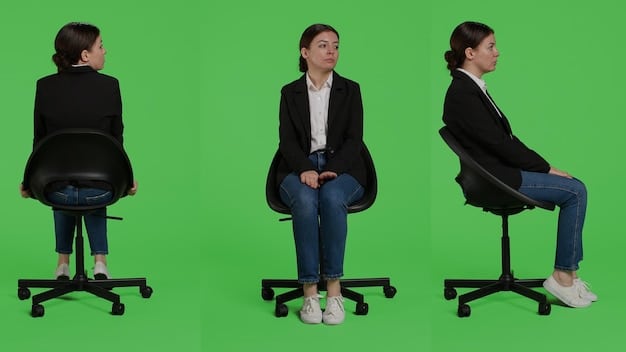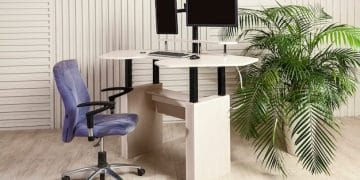Ergonomic Office Chairs: Do They Really Boost Productivity by 15%?

The Ultimate Review: This article delves into the promise of new ergonomic office chairs to boost productivity by 15%, examining their design, features, and scientific evidence to determine if they live up to the claim.
Are you tired of backaches and the mid-afternoon slump while working from home or in the office? The promise of a 15% productivity boost from new ergonomic office chairs sounds tempting. But do these chairs really live up to the hype?
The Ergonomic Revolution: A Deep Dive
Ergonomics has become a buzzword in office environments, promising to alleviate physical strain and enhance overall well-being. But what exactly does it entail, and how do these chairs propose to revolutionize our workday?
This section will explore the core principles of ergonomics and how they’re applied in the design of modern office chairs, focusing on posture, support, and adjustability features that aim to mitigate the adverse effects of prolonged sitting.
Understanding Ergonomic Principles
Ergonomics is the science of designing and arranging workplaces, products, and systems to fit the people who use them. In the context of office chairs, it’s about creating a seat that supports the body’s natural posture and minimizes strain.
Key Features of Ergonomic Chairs
Ergonomic chairs often come with a suite of adjustable features designed to cater to individual needs. These features typically include adjustable height, lumbar support, armrests, and seat depth.

- Adjustable Lumbar Support: Provides crucial support for the lower back, reducing the risk of back pain.
- Adjustable Height: Allows users to position their feet flat on the floor, maintaining proper leg and hip alignment.
- Adjustable Armrests: Reduces strain on the neck and shoulders by supporting the arms and allowing for relaxed shoulders.
- Breathable Materials: Mesh backing promotes airflow and prevents overheating during long work hours.
In conclusion, the ergonomic revolution in office chair design focuses on providing customizable support to align the body, minimize strain, and promote comfort during extended periods of sitting.
The 15% Productivity Claim: Fact or Fiction?
The bold promise of a 15% productivity boost is often associated with ergonomic office chairs. But is there solid scientific backing to justify this claim, or is it merely a marketing ploy?
This section will dissect the studies and research surrounding ergonomic interventions, analyzing whether there’s a direct causal link between using ergonomic chairs and an increase in workplace productivity.
Analyzing Scientific Studies
Several studies have investigated the impact of ergonomic interventions on productivity. While some studies show positive correlations, others suggest that the benefits are more nuanced.
The Role of Placebo Effect
It’s essential to consider the potential influence of the placebo effect. The mere belief that a new ergonomic chair will improve productivity could lead to a temporary increase in performance, regardless of the chair’s actual design.
- Improved Comfort: Ergonomic chairs can enhance comfort, reducing distractions and enabling employees to focus better.
- Reduced Pain: By minimizing back pain and discomfort, ergonomic chairs can prevent interruptions and sick days.
- Enhanced Posture: Good posture promotes better breathing and circulation, potentially leading to increased energy levels.
In conclusion, while a direct 15% productivity boost may be an oversimplification, ergonomic chairs can contribute to a more comfortable and supportive work environment, potentially leading to increased efficiency and reduced absenteeism.
Top Ergonomic Office Chairs on the Market
With a vast selection of ergonomic office chairs available, choosing the right one can be overwhelming. So, in response to this need, this section provides a curated list of top-rated ergonomic chairs based on comprehensive reviews and user feedback.
We will evaluate each chair based on its features, adjustability, comfort, and overall value, helping you make an informed decision that aligns with your specific needs and budget.

Herman Miller Aeron: The Icon
The Herman Miller Aeron is a classic ergonomic chair renowned for its innovative design and customizable features. Its breathable Pellicle mesh and adjustable PostureFit SL lumbar support ensure optimal comfort and support.
Steelcase Gesture: The Adaptable Choice
The Steelcase Gesture is designed to mimic the natural movements of the human body, providing exceptional support and flexibility for various postures and tasks. Its 360-degree armrests and adjustable backrest offer unparalleled customization.
Ultimately, the best ergonomic office chair depends on individual preferences and specific needs. Consider factors such as body type, work style, and budget when making your final decision.
Setting Up Your Ergonomic Chair for Optimal Productivity
Acquiring an ergonomic office chair is just the first step. To truly unlock its potential productivity benefits, it’s crucial to set it up correctly and integrate it into a well-designed workspace.
This section will provide practical tips and guidelines on adjusting your chair to achieve optimal posture, minimize strain, and maximize comfort throughout the workday.
Proper Chair Height and Posture
Adjust your chair height so that your feet are flat on the floor and your knees are bent at a 90-degree angle. Maintain a straight back and avoid slouching or hunching forward.
Adjusting Lumbar Support and Armrests
Position the lumbar support to fit the natural curve of your lower back. Adjust the armrests so that your elbows are bent at a 90-degree angle and your shoulders are relaxed.
- Monitor Placement: Position your monitor at arm’s length and slightly below eye level to prevent neck strain.
- Regular Breaks: Take short breaks every 30-60 minutes to stand up, stretch, and move around to improve circulation and reduce fatigue.
- Keyboard and Mouse Positioning: Place your keyboard and mouse close to your body to avoid reaching and straining your arms and shoulders.
In conclusion, properly setting up your ergonomic chair and integrating it into a well-designed workspace is essential for maximizing its benefits and achieving optimal posture and productivity.
Beyond the Chair: Creating an Ergonomic Workspace
While an ergonomic chair is a crucial component of a healthy workspace, it’s just one piece of the puzzle. To truly maximize productivity and well-being, it’s vital to consider the broader environment and implement additional ergonomic strategies.
This section will explore various elements of an ergonomic workspace, including desk setup, lighting, and accessories, providing practical tips on creating a comfortable and efficient work environment.
Desk Height and Monitor Placement
Ensure your desk height is appropriate for your body size, allowing you to maintain a neutral posture while typing and using the mouse. Position your monitor at arm’s length and slightly below eye level to prevent neck strain.
Lighting and Environmental Factors
Optimize lighting to reduce glare and eye strain. Position your desk near a window to maximize natural light, and use adjustable lamps to supplement artificial lighting as needed. Consider factors such as humidity and temperature to create a comfortable workspace.
In summary, creating an ergonomic workspace involves optimizing various environmental factors, minimizing distractions, and promoting movement and flexibility throughout the workday.
Long-Term Benefits of Ergonomic Investments
Investing in ergonomic equipment, such as office chairs, extends beyond immediate productivity gains. The long-term health and well-being benefits associated with ergonomic interventions can have a significant impact on employee satisfaction, retention, and overall organizational success.
This section highlights the long-term advantages of prioritizing ergonomics in the workplace, emphasizing the importance of creating a sustainable and supportive work environment.
Reduced Risk of Musculoskeletal Disorders
Ergonomic interventions can significantly reduce the risk of musculoskeletal disorders (MSDs), such as carpal tunnel syndrome, back pain, and neck pain, which can lead to chronic pain and disability.
Improved Employee Morale and Engagement
When employees feel supported and comfortable in their work environment, their morale and engagement levels tend to increase. Ergonomic investments demonstrate a commitment to employee well-being, fostering a positive and productive workplace culture.
- Reduced Healthcare Costs: Preventing MSDs and other ergonomic-related injuries can lead to lower healthcare costs for both employees and employers.
- Increased Employee Retention: A comfortable and supportive work environment can improve employee retention rates, reducing the costs associated with turnover and recruitment.
- Enhanced Company Reputation: Companies that prioritize ergonomics and employee well-being often enjoy a positive reputation, attracting top talent and enhancing their brand image.
To conclude, investing in ergonomics is a strategic decision that yields significant long-term benefits, promoting employee health, productivity, and overall organizational success.
| Key Point | Brief Description |
|---|---|
| ✅ Ergonomic Design | Supports posture; reduces strain. |
| 📈 Productivity Claim | 15% boost may be optimistic. |
| 🛠️ Proper Setup | Essential for maximizing benefits. |
| 🏢 Workspace Design | More than the chair matters. |
FAQ
▼
Ergonomic chairs can significantly reduce back pain by promoting better posture and providing lumbar support, though complete elimination depends on the individual’s overall health and habits.
▼
Adjust your ergonomic chair as needed throughout the day to maintain proper posture and comfort, especially after prolonged sitting or changing tasks to ensure alignment.
▼
Expensive ergonomic chairs often offer superior adjustability, durability, and comfort, making them a worthwhile investment for those who spend many hours sitting each day.
▼
Ergonomic chairs can improve focus by reducing discomfort and distractions, allowing you to concentrate better on your tasks without being hindered by physical pain.
▼
Essential features include adjustable lumbar support, seat height, armrests, and tilt mechanisms to ensure proper alignment and comfort during extended periods of sitting and working.
Conclusion
While the promise of a definitive 15% productivity boost from ergonomic office chairs may be an overstatement, the benefits they offer in terms of comfort, posture support, and long-term health are undeniable. Investing in an ergonomic chair and creating a well-designed workspace is a worthwhile commitment to your well-being and productivity.

![Is the updated [product] truly better? A deep dive into enhancements Is the updated [product] truly better? A deep dive into enhancements - Cover Image](https://youforyous.com/wp-content/uploads/2025/07/youforyous.com_4_1753831175_a20b5125_cover-360x180.jpg)



